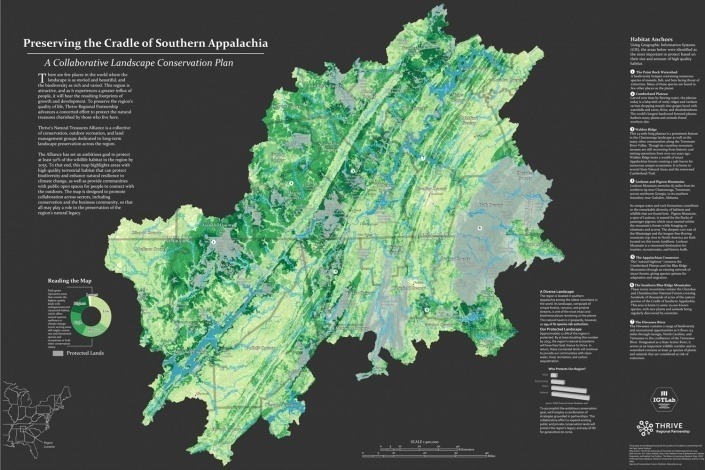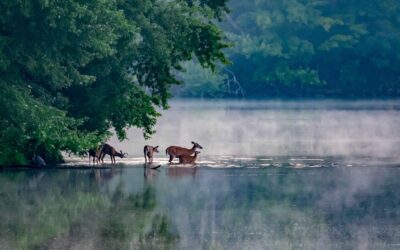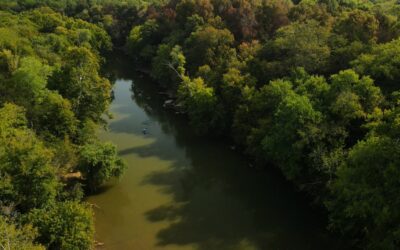In a small corner of the Southeast, a sustainable economic development organization launches a bold vision to preserve the region’s Appalachian beauty and way of life. Map designed for Thrive Regional Partnership by the IGTLab of the University of Tennessee at Chattanooga.
People don’t just enjoy nature—we need it.
Thrive Regional Partnership recently launched The Cradle of Southern Appalachia initiative, a tri-state, collaborative landscape conservation blueprint to protect the region’s highest-quality natural areas.
Tennessee Wildlife Federation is a proud partner.
The initiative has been endorsed by Thrive’s Natural Treasures Alliance, a collective of conservation, outdoor recreation, and land management groups dedicated to long-term, voluntary conservation across the region.
The Cradle of Southern Appalachia initiative identifies areas that, if protected, would increase wildlife habitat and would better prepare the region in the face of increasing natural emergencies such as wildfire, flood, and drought. These areas would also improve physical and mental health by providing communities with healthy, public open spaces for people to connect with each other and the outdoors.
“Working with our partners on this initiative has been very rewarding for our local conservation organization,” said Rick Huffines, Executive Director of the Tennessee River Gorge Trust. “Thrive quickly realized that the collective value of the natural assets reach well beyond the conservation field. This collaborative approach on a regional scale works not only for the conservation community, but also for our economic, educational, and infrastructure partners as well. This is how conservation efforts must work going forward.”
Collaboration is Key
The data model used in the initiative, built by the University of Tennessee at Chattanooga’s Interdisciplinary Geospatial Technology Lab (IGTLab), is available for planning and outreach purposes beyond the conservation community. It is intended to be used as a resource by national, state, and local leaders in traditional sectors such as economic development and transportation planning to incorporate smart growth into their infrastructure decisions.
“The Cradle of Southern Appalachia Initiative provides an important blueprint for conserving critical wildlife habitat and recreational opportunities in the Southern Appalachian region. Tennessee Wildlife Federation is excited to be part of the Initiative and will use the information to prioritize our work in the region,” said Chris Roberts, director of conservation for Tennessee Wildlife Federation.
In addition to endorsing the blueprint, Thrive’s Natural Treasures Alliance has agreed to collaboratively strive toward the following outcomes by 2055, in order to preserve the region’s quality of life and protect its natural areas from encroaching development:
- Double the amount of protected woodlands
- Improve water quality of at least 50% of polluted streams in the region
- Keep common species common by protecting 90% of at-risk fish, plants, and wildlife
- Foster conservation awareness and education
A Unique Approach
Though not the only conservation plan of its kind, most of these plans are organized by land protection agencies alone. What makes the Cradle of Southern Appalachia initiative unique from a national perspective, is that it is a culmination of years of public input facilitated by Thrive, an organization with mutual purposes of protecting the region’s landscape while ensuring a sustainable economic future for its communities.
“Thrive’s blueprint is a novel effort to integrate land conservation for wildlife, water quality and recreation in a larger vision of regional livability,” said Peter Howell, executive vice president at the Open Space Institute which has supported land conservation in the region since 2007 and was a key partner in the development of the blueprint. “Through its robust partnership that engages the private and nonprofit sectors, Thrive has provided a model for what conservation must look like in the 21st century: grounded in science, broad-based, culturally sensitive, and committed to sustaining both the natural world and economic livelihoods.
Thrive Regional Partnership invites partners outside the conservation community to join this effort to safeguard the region’s quality of life for future generations. The nonprofit is available to connect the general public, planning groups, private industry, and the media with the network of specialists and resources they need to ensure the natural heritage of their properties and communities is preserved.
Thrive Regional Partnership inspires responsible growth through conversation, connection, and collaboration in the tri-state greater Chattanooga region.




